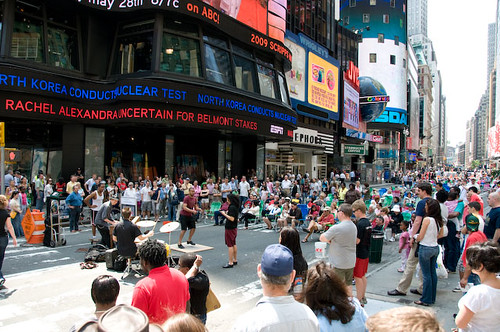Yesterday’s Active Transportation Alliance announcement submitting 20 streets for consideration as partial or total car-free spaces has already sparked a lively dialogue. Stories in the Tribune, Sun-Times, ABC, and DNAinfo have all examined whether or not the automobile-dominated status quo represents an appropriate allocation of public space.
The boldest proposal on the Active Trans list -- pedestrianizing the iconic North Michigan shopping district -- was inspired by Transitized blogger and Streetsblog Chicago contributor Shaun Jacobsen’s call for a Mag Mile free of motor vehicles. “Michigan Ave is full of cars that do not need to be there,” he wrote, suggesting the removal of auto traffic from the strip, funneling all cross traffic under the avenue via Grand and Illinois and relocating the many bus routes to nearby State.
Another variation could preserve bus and taxi service on the street to provide access to stores and office buildings along the corridor, but there really is no pressing need for private cars to use Michigan. As Jacobsen pointed out, most cars on the “Boul Mich” represent people simply passing through on the way to somewhere else, not stopping to contribute to the local economy. The avenue might work quite well as a car-free transit boulevard. At the very least, a few of the roadway’s six lanes could easily be repurposed for dedicated bus lanes, wider sidewalks, seating areas, and/or protected bike lanes.
“The slog of vehicles divides the two sides of this shopping mecca where there are so many people on foot,” Active Trans director Ron Burke told the Sun-Times. “For these reasons, it’s a good candidate for further analysis.”
In the same piece, downtown alderman Brendan Reilly dismissed the idea. “I don’t think turning Michigan Avenue into a pedestrian mall makes sense," Reilly said. "We saw that experiment fail on State Street. I’m not sure why we’d want to replicate that."
And John Chikow, president of The Magnificent Mile Association, was also less than enthusiastic about transforming the street. “I’m looking out the window right now and everything is flowing pretty good,’’ said Chikow. “I don’t know what they are talking about.”
I’d like to think Chicago’s business leaders don’t have any less vision than their New York City counterparts. But that city would never have pulled off its game-changing public space transformations, such as the pedestrianization of Times Square, without the Midtown business district leaders spearheading these bold initiatives. Retail values along Broadway soared after the street was opened up to people on foot. Chikow's constituents would presumably be thrilled to see similar results with their properties.
At a 2010 press conference announcing that the new public spaces along Broadway, which had been piloted for eight months, would become permanent, Dan Biederman, president of the 34th Street Partnership business association, lauded the change:
This is a 21st Century idea. The 20th Century idea was three lanes of noisy, annoying traffic going right past all these great institutions and stores. The 21st Century idea is seating and pedestrian life dominating and traffic being subsidiary.
The good news is that Chikow says he’s at least willing to listen to Active Trans’ pitch. “I’d love them to come to [our] monthly meeting and share their thoughts,” he said. Whether or not it makes sense to completely remove cars from the Mag Mile or simply turn over some of that space to other uses remains to be seen, but business leaders and the city government should definitely give the idea serious consideration.






